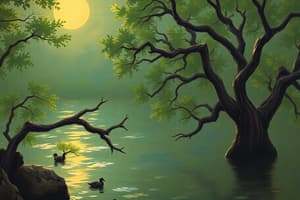Podcast
Questions and Answers
What is the role of producers in an ecosystem?
What is the role of producers in an ecosystem?
- They consume other organisms to obtain energy.
- They are apex predators that control the population of other species.
- They create their own food through photosynthesis or chemosynthesis. (correct)
- They provide nutrients to tertiary consumers.
What defines a primary consumer?
What defines a primary consumer?
- An organism that feeds on producers or autotrophs. (correct)
- An organism that exclusively feeds on carnivores.
- An apex predator in the food chain.
- An organism that can consume both plants and animals.
Which statement accurately describes tertiary consumers?
Which statement accurately describes tertiary consumers?
- They are the primary agents of photosynthesis.
- They are apex predators with no natural enemies.
- They are typically herbivores that feed on plants.
- They predominantly feed on primary consumers. (correct)
How does energy flow in a food web compared to a food chain?
How does energy flow in a food web compared to a food chain?
What percentage of energy is typically transferred from one trophic level to the next?
What percentage of energy is typically transferred from one trophic level to the next?
Which of the following correctly identifies a quaternary consumer?
Which of the following correctly identifies a quaternary consumer?
What is the primary characteristic of omnivores in the context of trophic levels?
What is the primary characteristic of omnivores in the context of trophic levels?
What acts as the base of the food chain in a freshwater lake ecosystem?
What acts as the base of the food chain in a freshwater lake ecosystem?
In a food chain, what happens to energy when one organism consumes another?
In a food chain, what happens to energy when one organism consumes another?
Which organism in a freshwater lake ecosystem consumes aquatic insects?
Which organism in a freshwater lake ecosystem consumes aquatic insects?
What is the primary method by which aquatic plants produce energy?
What is the primary method by which aquatic plants produce energy?
What defines the trophic levels in an ecosystem?
What defines the trophic levels in an ecosystem?
Which of the following is a secondary consumer in a freshwater lake food chain?
Which of the following is a secondary consumer in a freshwater lake food chain?
What is the correct sequence of energy flow in a food chain?
What is the correct sequence of energy flow in a food chain?
In a food chain diagram, which organisms would be represented at the highest trophic level?
In a food chain diagram, which organisms would be represented at the highest trophic level?
Flashcards are hidden until you start studying
Study Notes
Ecosystems and Food Chains
- Ecosystems are complex interactions between living organisms and their environment.
- Food chains represent the feeding relationships within an ecosystem, showing who eats whom.
- Energy flows through an ecosystem by feeding, moving from one organism to another.
- Examples of food chains include:
- Terrestrial: Grass - Plant-eating insects - Meat-eating insects - Frog - Snake - Bird of prey
- Marine: Algae - Plankton - Crustaceans - Fish - Dolphin - Shark
Trophic Levels in Food Chains
- Trophic levels define the position of organisms in a food chain or food web based on their source of energy.
- Energy flow moves upwards through the trophic levels, from producers to consumers.
- The base of the trophic pyramid is formed by producers, which create their own food through photosynthesis or chemosynthesis.
- Primary consumers are herbivores feeding on producers.
- Secondary consumers are carnivores or omnivores feeding on primary consumers.
- Tertiary consumers are carnivores or omnivores feeding on secondary consumers.
- Quaternary consumers are apex predators feeding on tertiary consumers and below.
Types of Consumers
- Herbivores consume only plant matter.
- Carnivores consume only meat.
- Omnivores consume both plant and animal matter.
Food Webs and Energy Flow
- Food webs represent multiple interconnected food chains within an ecosystem.
- They illustrate the complex energy flow between organisms in different food chains.
- The energy flow in a food web is not perfectly linear, but can be transferred between organisms in different food chains.
- Energy transfer between trophic levels is not 100% efficient, with approximately 10% of the energy from the lower level being transferred to the higher level.
- The remaining energy is lost due to heat, metabolism, or unconsumed matter.
Studying That Suits You
Use AI to generate personalized quizzes and flashcards to suit your learning preferences.




